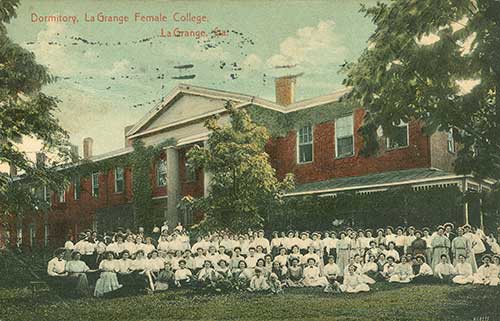
The college’s origins reach back to the settlement of West Georgia in the early 1800s. When the land between the Flint and Chattahoochee rivers was opened in 1827, one of the five counties formed on the western border of the state was named Troup, in honor of Governor George Michael Troup.
The Georgia Legislature passed an act on Dec. 24, 1827, providing for the selection of a county seat. It was named LaGrange, after the country estate of the Marquis de Lafayette, the Revolutionary War hero who had visited the region in 1825 as the guest of Governor Troup. During his tour of the region, he is said to have remarked that the landscape reminded him of his estate back home. The site for the town was purchased in 1828, and LaGrange was incorporated late that year.
On Dec. 26, 1831, the charter for LaGrange Female Academy was granted at the state capitol. Andrew Jackson was president of the United States, and there were only 24 states in the union. Abraham Lincoln was 22 years old. Atlanta did not yet exist. There were no fountain pens, typewriters or automobiles, and the fastest means of transportation in the region was by horse. The only other college in the state was Franklin College, now the University of Georgia.
The first location of LaGrange College was in a large white building at what is now 406 Broad St. The school moved two blocks west to its present location, the highest geographical point in LaGrange, 18 years later.
In 1847, the school became LaGrange Female Institute, and the charter was amended to allow the school the power to confer degrees. The name was changed to LaGrange Female College in 1851.
The Georgia Conference of the Methodist Episcopal Church South took ownership of the college in 1856. Today, it is an institution of the North Georgia Conference of the United Methodist Church.
As the Civil War progressed across Georgia, Smith Hall served as a hospital for wounded soldiers. Several colleges were forced to close their doors, but classes at LaGrange Female College continued uninterrupted.
In 1920, Bishop Warren Aiken Candler suggested that LaGrange Female College be moved to Atlanta. Students, the community and people of all denominations reacted by giving their time and money for the improvement of the college. Every student in town was seen wearing a badge bearing the words “Save our college for me,” and the drive brought in a quarter of a million dollars in donations.
LaGrange Female College became LaGrange College in 1934, opening the door for several males to attend. They were considered such a distraction that most remained only one semester. It was more than 10 years before men were actively recruited again. In 1953, the college officially became coeducational.
Today, LaGrange College is a four-year liberal arts and sciences college ranked in the top 10 and as a “best value” among more than 100 Southern comprehensive colleges by U.S. News & World Report. Enrollment stands at approximately 1,000 students, and the student-faculty ratio is 11-to-1.
The college offers more than 50 academic and pre-professional programs, including graduate degrees in Education and Clinical Mental Health Counseling. It has welcomed students of all faiths and denominations since its inception, and it has a strong emphasis on servant-leadership and global engagement.
LaGrange College holds a membership in the National Collegiate Athletic Association (NCAA) Division III. Men compete on intercollegiate sports teams in baseball, basketball, cross country, football, golf, lacrosse, soccer, tennis and track. Women’s intercollegiate sports include basketball, beach volleyball, cross country, flag football, golf, soccer, softball, tennis, track and volleyball.

